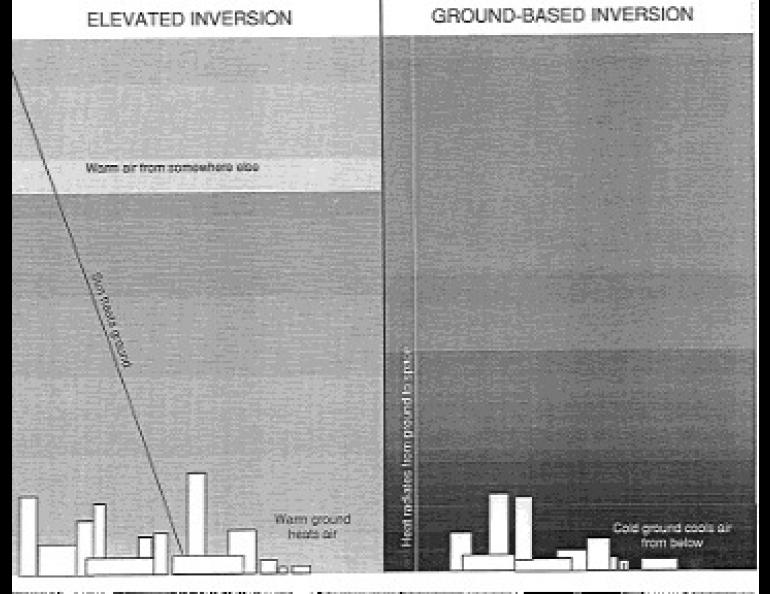
Alaska's Polluted Air
Ice fog. Wood smoke. Carbon monoxide. Why should Alaska, with its miles of wilderness, little heavy industry, and a total population less than most cities with poor air quality, have so many problems with air pollution?
The buildup of air pollution resembles the filling of a leaky bucket. The size of the bucket is determined by vertical mixing, while the leakiness is controlled by wind speed. You'd need a waterfall to fill an enormous bucket with many large leaks, but a trickle of water could overflow a small bucket with a single pinhole. Alaskan lowland areas in winter are small buckets with very minor leaks. By contrast, areas like Los Angeles or Denver are much larger and leakier, but with much faster rates of inflow.
The vertical mixing that controls the bucket size is in turn controlled by inversions -- warm air lying over colder air. Since the colder air is denser, it is unable to mix freely with the warmer air above.
In places where there is plenty of sunshine, the sun heats the ground, which in turn heats the adjacent air, so there is generally a well-mixed layer near the surface. If an anticyclone (high pressure area) with hot, downward-moving air lies over the cooler, well-mixed layer near the ground, it will produce an elevated inversion. Usually, however, such an inversion will be a thousand feet or more above the surface. This is the situation that produces most air pollution problems in the other 49 states, especially in summer.
In most of Alaska in the winter, there is not enough sunshine to heat the snow-covered ground. Instead, the ground is actually losing energy to space via infrared emission. The result is that the ground, far from warming the overlying air and promoting mixing, actually becomes the coldest place around, and all vertical mixing is suppressed. The extent of this suppression depends on wind speed (which forces mixing by "bouncing" over trees, houses, and hills) and cloud cover (which can radiate infrared radiation right back to the ground as fast as the ground emits it).
When winds are light and the sky is clear, the size of the bucket in undisturbed areas is close to zero. In downtown Fairbanks, where cars add heat as well as carbon monoxide, the depth of the well-mixed air layer is still only about thirty feet -- a very small bucket compared with more than a thousand feet in Los Angeles. In Anchorage clear skies and light wind speeds are not quite as common, but when they occur the mixing depths are probably not much greater than in Fairbanks, so the bucket is not much larger but the number of cars, and thus the rate of fill, is greater.
Residential valleys in both Juneau and Whitehorse have the same conditions, though the major pollutant there is wood smoke. In fact, thermal infrared satellite images show that almost every valley in Alaska is subject to winter inversions.
One final comment: in both Fairbanks and Anchorage, the carbon monoxide concentrations are highest, and cold-start emissions are worst, when the temperatures are between twenty below and twenty above. Since average Fairbanks winter temperatures are below the middle of this range while average winter temperatures in Anchorage are above it, the warming which has occurred during the last few winters would be expected to decrease the amount of air pollution in Anchorage, while increasing it in Fairbanks. The result is that Anchorage air quality has improved by about twice the amount that can be accounted for by emissions testing, while in Fairbanks, where the number of cars has increased as well, emissions testing has just about managed to balance the decreased mixing.





